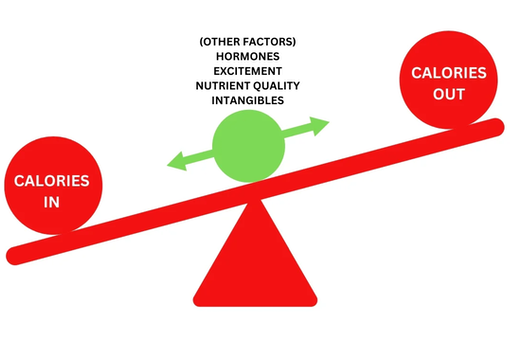
How Many Calories Do I Need? A Step-by-Step Guide to Determining Your Ideal Intake
Whether you’re an avid athlete, a weekend warrior, or just someone trying to maintain a healthy lifestyle, understanding your caloric needs is key. Calories are the energy currency your body uses to perform every function, from the most basic, like breathing, sleeping, and binge-watching your favorite show, to the most strenuous, like lifting weights or running marathons.
In this guide, we’ll break down how to determine how many calories you need for both everyday living and training. You’ll learn how to calculate your Basal Metabolic Rate (BMR) — the number of calories your body needs at rest — and how to adjust that number based on your activity level and health goals.
We’ll also share some practical tips for sticking to your target calorie intake, but first, let’s lay some groundwork.
What Are Calories, Anyway? 🤔
You’ve heard the word “calorie” a million times, but what actually is a calorie? Simply put, it’s a standard unit of measurement for energy. When you eat or drink, your body breaks down the nutrients in the food and converts them into energy, measured in calories. This energy is then used to perform various bodily functions, from maintaining your heartbeat to powering a workout.
IMPORTANT NOTE: It's definitely not ALL about calories. However, what we put in our mouths is one of the easiest variables to track and manipulate. Thus, getting that variable dialed in deserves our time and attention. Of course, hormones, nutrient density, genetics, and many other factors all play a role. However, it's much easier to manipulate the amount of calories you consume than it is to change your genetics so take a wholistic approach and control the controllable.
Energy Balance: Calories In vs. Calories Out
Maintaining the perfect energy balance is key to hitting your health and fitness targets, whether you’re looking to shed pounds, add healthy weight, get shredded, or keep your current physique. Here’s how it works:
- Weight Maintenance: When your calorie intake matches your calorie expenditure, your weight remains stable.
- Weight Loss: To lose weight, you need to create a caloric deficit by consuming fewer calories than you burn. This forces your body to use stored fat for energy.
- Weight or Muscle Gain: To gain weight, you need to create a caloric surplus by consuming more calories than you burn. This provides the extra energy required to build muscle and gain weight.
Calculating Your Basal Metabolic Rate (BMR) 🔢
Your Basal Metabolic Rate (BMR) is the number of calories your body needs to perform basic physiological functions while at rest. These functions include things like breathing, circulating blood, controlling body temperature, and cellular processes.
Essentially, BMR represents the minimum number of calories necessary to keep you alive. It does not include the extra calories needed for everyday activities like walking, moving, and exercising.
Factors Affecting BMR
Several factors influence your BMR, including:[*]
- Age: BMR decreases with age due to the loss of lean body mass and changes in hormonal levels.
- Gender: Generally, men have a higher BMR than women because they tend to have more muscle mass.
- Weight and Height: Larger bodies require more energy to maintain basic functions.
- Body Composition: Muscle tissue burns more calories at rest than fat tissue, so individuals with higher muscle mass have a higher BMR.
- Genetics: Your genetic makeup can also play a role in determining your BMR.
There are several equations you can use to estimate your Basal Metabolic Rate (BMR), with the Mifflin-St Jeor Equation being the most widely used. To calculate your BMR using this equation, you’ll need one of the following formulas:[*]
- Males: 10 x weight (in kilograms) + 6.25 x height (in centimeters) – 5 x age (in years) + 5
- Females: 10 x weight (in kilograms) + 6.25 x height (in centimeters) – 5 x age (in years) – 161
Don’t worry, you won’t need to dust off your old math textbooks — it’s easier than it looks! Let’s break it down with an example, calculating the BMR for a 40-year-old female who weighs 150 pounds (68 kg) and is 5’5” (167 cm) tall.
This woman’s BMR equation would look like this:
10 x 68 kg (weight) + 6.25 x 165 cm (height) – 5 x 40 (age) – 161 = ~1,350 calories.
No fancy tricks required — just use a calculator and input the numbers step by step. It’s important to note that while the Mifflin-St Jeor Equation is thought to be one of the most accurate equations, its result can be off by around 10% of your true BMR.[*]
Factoring In Your Activity Level 🏃🏽♂️
Your BMR (Basal Metabolic Rate) represents the number of calories your body needs to maintain vital functions while at rest. However, because people are rarely completely inactive throughout the day, this number is just the starting point. To determine your actual caloric needs, you must factor in the energy expended through all forms of activity, from simple movements like walking to more strenuous exercises.
This is where TDEE (Total Daily Energy Expenditure) comes in.[*] To calculate your TDEE, you need to multiply your BMR by your activity factor:
- Sedentary (little or no exercise): BMR x 1.2
- Lightly active (light exercise/sports 1-3 days a week): BMR x 1.375
- Moderately active (moderate exercise/sports 3-5 days a week): BMR x 1.55
- Very active (hard exercise/sports 6-7 days a week): BMR x 1.725
- Extra active (very hard exercise/sports & a physical job): BMR x 1.9
Let’s use an example of a 30-year-old man with a BMR of 1,800 calories per day who is moderately active.
The equation would be: 1,800 (BMR) x 1.55 (activity factor) = 2,790. This number tells us the approximate number of calories he’d need daily to maintain his current weight.
Adjusting Your TDEE for Your Health Goals ✔️
So, what if you have specific health goals, like losing weight, gaining weight, or bulking up? Here’s how to approach each goal effectively.
Weight Loss
As mentioned, to shed those extra pounds, you need to create a caloric deficit, which means consuming fewer calories than your TDEE. This forces your body to use stored fat for energy. Start by gradually reducing your caloric intake to see how your body responds and determine your rate of weight loss.
To boost your weight loss, consider adopting a ketogenic (keto) diet, which is high in fat, moderate in protein, and low in carbs. This way of eating has been shown to help with fat loss while preserving muscle mass. In one study, people on a keto diet lost a little over two times more weight than those on a low-calorie, low-fat diet.[*]
The weight loss benefits on keto are likely due to a mix of effects, namely better insulin sensitivity, feeling less hungry, and increased fat burning.[*][*][*]
Weight Gain
To gain weight, you need to create a caloric surplus, meaning you consume more calories than the amount you burn every day (aka your TDEE). Aim for a slight surplus. You can always adjust from there to increase or decrease the speed of weight gain.
Bulking Up
Building muscle involves increasing muscle mass while minimizing fat gain. This requires a more strategic approach to diet and exercise.
- Caloric Surplus: Aim for a caloric surplus.
- Protein Intake: Most studies suggest that eating 0.7–0.9 grams of protein per pound of body weight (1.6–2.0 grams per kg) is ideal for building muscle.[*][*] Good keto sources of protein include meat, poultry, eggs, fish, grass-fed whey protein (which is found in several Keto Brick flavors), nuts, and seeds.
- Progressive Overload: Continuously challenge your muscles by gradually increasing the weight or resistance in your strength training routine.
- Rest and Recovery: Allow adequate time for muscle recovery. Muscles grow during rest, not during the workout itself.
Psst! Discover how to fuel up before a workout and maximize your performance with the right nutrition.
Practical Tips and Strategies 💡
Understanding your caloric needs is the first step, but putting this knowledge into practice is where the real magic happens. Here are some practical tips and strategies to help you meet your calorie needs effectively, whether your goal is weight loss, weight gain, muscle building, or maintenance.
Meal Plan and Prep
- Plan Ahead: Create a weekly meal plan that outlines your meals and snacks. This helps ensure you’re meeting your caloric and nutritional needs consistently.
- Prep in Batches: Cook and prepare meals in bulk to save time and avoid the temptation of unhealthy options. Store meals in portion-controlled containers for easy access.
- Include Variety: Incorporate a variety of foods to ensure you’re getting a wide range of nutrients and prevent food boredom.
Read Nutrition Labels
- Check Serving Sizes: Pay attention to the serving sizes on nutrition labels to accurately track your caloric intake.
- Focus on Macronutrients: Look for the amounts of protein, carbohydrates, and fats in each serving. This helps you manipulate your macronutrient intake according to your goals.
- Identify Hidden Calories: Be mindful of added sugars and unhealthy fats (like seed oils) that can increase the calorie content and reduce the health benefits of seemingly healthy foods.
Use Apps and Tools
- Track Your Intake: Use apps like Cronometer to log your food intake and monitor your calorie and nutrient consumption.
- Set Goals: Many apps allow you to set personalized goals for calories and macronutrients. Adjust these settings based on your TDEE and specific health objectives.
- Analyze Trends: Review your intake patterns regularly to identify areas for improvement and make necessary adjustments.
Adjust Intake Based on Progress
- Monitor Your Weight: Weigh yourself regularly (e.g., weekly) to track your progress. Remember that weight can fluctuate daily due to various factors, so focus on long-term trends.
- Listen to Your Body: Pay attention to how your body responds to different caloric intakes. Adjust your diet if you consistently feel hungry or fatigued, or if you’re not seeing desired results.
- Recalculate TDEE: Your Total Daily Energy Expenditure (TDEE) can change due to factors such as changes in weight, activity level, or age. Periodically recalculating your TDEE ensures that your caloric intake remains aligned with your current needs and goals.
Consider Keto Brick for Convenient Nutrition 🙌🏼
Do any of these sound like you?
- You’re on a keto diet and looking for a convenient way to boost your fat intake to keep your body running like a fat-burning machine 🔥
- You’re an athlete or adventurer looking for a protein-rich, on-the-go snack to fuel your performance and keep you energized throughout the day 🏋🏽♀️
- You want to gain a healthy amount of weight and are looking for quick and easy calorie-dense options 𐄷
If so, Keto Brick is calling your name! These shelf-stable,1,000-calorie performance bars are your partner in health and adventure. Each bar has the perfect keto macros (81.5% fat, 12.5% protein, and 6% carbs), making meal prep, snack time, and macro tracking a piece of (keto) cake.Plus, they’re crafted with only clean-label ingredients that you recognize and can pronounce (no word salad here).
💪🏼Fuel your wellness journey with our highly-rated Keto Brick flavors and make every calorie count!
Leave a comment
Comments will be approved before showing up.
